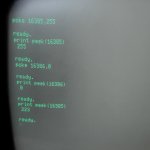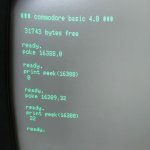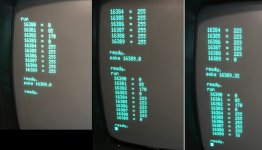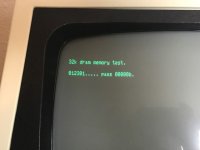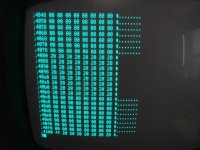Hutch
Experienced Member
I've been restoring a SP9000/8032 and have had a few problems with it so far, bad video RAM, bad Kernal ROM, but I got those fixed and the system started up normally.
I ran David Roberts PETTESTE2K (v4) from Bitfixer's ROMulator and it passed 13 cycles of the DRAM test with no failures. So I figured I was good.
Thanks for that program David, I appreciate it and it's been quite helpful.
Then I tried loading programs from disk and ran into problems that made me dig a little deeper.
Using Tynemouth's RAM/ROM board and replacing the RAM allowed everything to work normally. I narrowed it down to only the upper 16K bank. With the on-board RAM, it won't load anything from disk, but it's fine if I replace that 16K with the Tynemouth board.
So I re-ran PETTESTE2K and it still passes with no error, so I wrote my own basic program to test the upper 16K and figured it what was happening.
It seems the DRAM test is passing because it writes the same value to all of RAM at the same time.
But in this case, it looks like one bit (chip) is responding to all addresses. That is, if I write to any address, it changes that bit for ALL addresses, or it just outputs the same bit always, regardless of the address
See attached photo. It looks like a bad bit 5 in the upper 16K so UA8 I think.
I wanted to let David know about this failure mode just FYI. I know it's not meant to be a fully comprehensive test, I just thought this was an interesting failure mode.
If you're curious about the restore process so far, I'm doing a video series on YouTube here
I ran David Roberts PETTESTE2K (v4) from Bitfixer's ROMulator and it passed 13 cycles of the DRAM test with no failures. So I figured I was good.
Thanks for that program David, I appreciate it and it's been quite helpful.
Then I tried loading programs from disk and ran into problems that made me dig a little deeper.
Using Tynemouth's RAM/ROM board and replacing the RAM allowed everything to work normally. I narrowed it down to only the upper 16K bank. With the on-board RAM, it won't load anything from disk, but it's fine if I replace that 16K with the Tynemouth board.
So I re-ran PETTESTE2K and it still passes with no error, so I wrote my own basic program to test the upper 16K and figured it what was happening.
It seems the DRAM test is passing because it writes the same value to all of RAM at the same time.
But in this case, it looks like one bit (chip) is responding to all addresses. That is, if I write to any address, it changes that bit for ALL addresses, or it just outputs the same bit always, regardless of the address
See attached photo. It looks like a bad bit 5 in the upper 16K so UA8 I think.
I wanted to let David know about this failure mode just FYI. I know it's not meant to be a fully comprehensive test, I just thought this was an interesting failure mode.
If you're curious about the restore process so far, I'm doing a video series on YouTube here
Attachments
Last edited:

